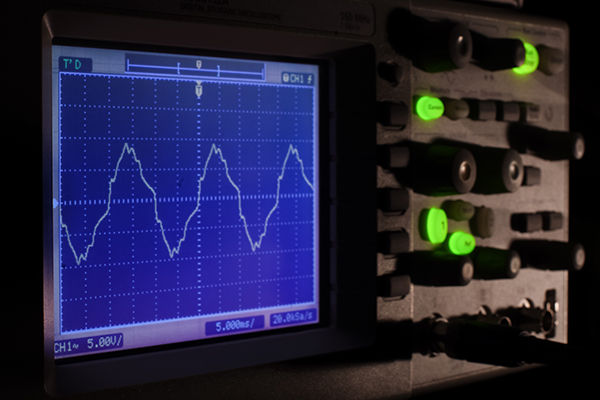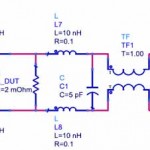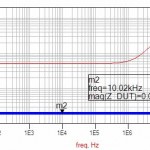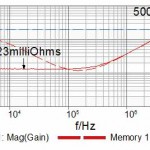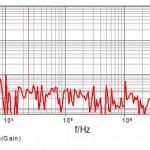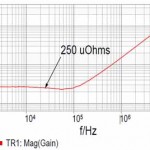This article discusses measurement of small resistances, such as those encountered during PDN measurement, using the OMICRON Lab Bode 100, Keysight E5061B, and the Picotest J2102A common mode transformer.
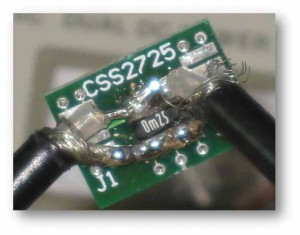

Figure 1, A 250uOhm current sense resistor is mounted with RG58 coax soldered directly to the resistor for measurement
The resistor being measured is a 250uOhm 1% resistor manufactured by Stackpole. The datasheet is not clear about how the device measurement is performed, though the resistor element is specified to be within 1% or 2.5uOhms.
Both the OMICRON Lab Bode 100 and the Agilent E5061B are capable displaying impedance in the 2-port measurement. They support the OPEN, SHORT and LOAD calibration in the 2-port series and shunt measurements for improved accuracy.
A common mode transformer is necessary for all measurements where the ground braid resistance is significant, as shown in Figure 2, unless the VNA has a differential or semi-floating 50Ω input. The Keysight E5061B is unique in that its low frequency gain-phase ports have semi-floating inputs and do not need the transformer. The higher frequency Port 1/2 inputs, as well as the Bode 100 and most other VNAs for that matter, do require the transformer in order to make the 2-port shunt measurement. The J2102A gets well above 100MHz, which is sufficient for general PDN use. Above that frequency the transformer is not really impactful.
- Figure 2 Schematic of the 2-Port impedance measurement including cable resistance, a 2mOhm DUT and the common mode transformer.
- Figure 3 Simulation results of the 2-port shunt thru impedance measurement including cable resistance and 2mΩ DUT with and without the common mode transformer
- Figure 4 Impedance measurement of the 1mΩ resistor with and without the J2102A common mode coaxial transformer using the OMICRON Lab Bode 100.
- Figure 5 Impedance measurement of the 2mΩ resistor, using Port 1 and Port 2, with and without the common mode coaxial transformer on the Keysight E5061B. The unique GP ports don’t require the transformer, but are limited to 30MHz.
By way of example, the simulation result of the 2mOhm case is shown in Figure 3, while sample measurements of 1 and 2 mOhm parts are shown in Figures 4 and 5, with and without the J2102A common mode transformer inserted. In order to quantify the significance, the approximate error is the parallel ground braid resistance divided by the DUT. For instance, a 5% error would occur at a DUT value of 1Ω as the parallel ground resistance is 50mΩ or 5% of 1Ω.
Moving on to our 250uOhm measurement, a DC measurement is made using precision, low noise 6.5 Digit DMM, as a point of reference.
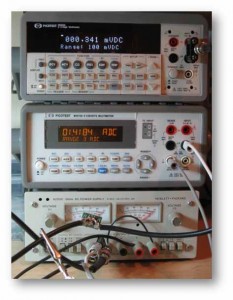

Figure 5 A DC measurement is made using precision, low noise 6.5 Digit DMMs (Picotest M3500A) to obtain a second measurement for correlation. The power supply does not have current programming, which is the reason the current is set to an odd number. The two channels of the power supply are connected in parallel and both are in current limit for this measurement.
The calculated DC resistance value is:
341uV/1.4184A=240uOhms
The noise floor of the measurement using the J2102A common mode transformer and a preamplifier is shown in Figure 6 below. Such a sample test is important and recommended as it confirms the validity and limits of the test setup.
The DMM measured value reflects an error of 4% from the specified value. The measurement error includes the error of the two DC meters and the 1 Ohm calibration resistor. The expected error in the measurement due to the 1 Ohm calibration is:
The measurement of the 250uOhm resistor is near perfect. Of course there are other errors, including the tolerance of the calibration resistor, the calibration of the two DMM’s and the gain accuracy of the VNA. There is also a cable shield resistance error, so the longer the cables the bigger the error.
The result would be considered to be excellent even if the result were further from the nominal, in order to account for these additional tolerances. It is clear that the Picotest J2102A common mode transformer and a preamp are indispensable when it comes to getting the most accuracy during PDN measurement.
- Figure 6 below – Noise floor in Ohms on the Bode 100 using the J2102A and the J2180A preamplifier included.
- Figure 4, The Bode 100 measurement of the 250uOhm resistor shown in Figure 1. The measured resistance and ESL are shown.


